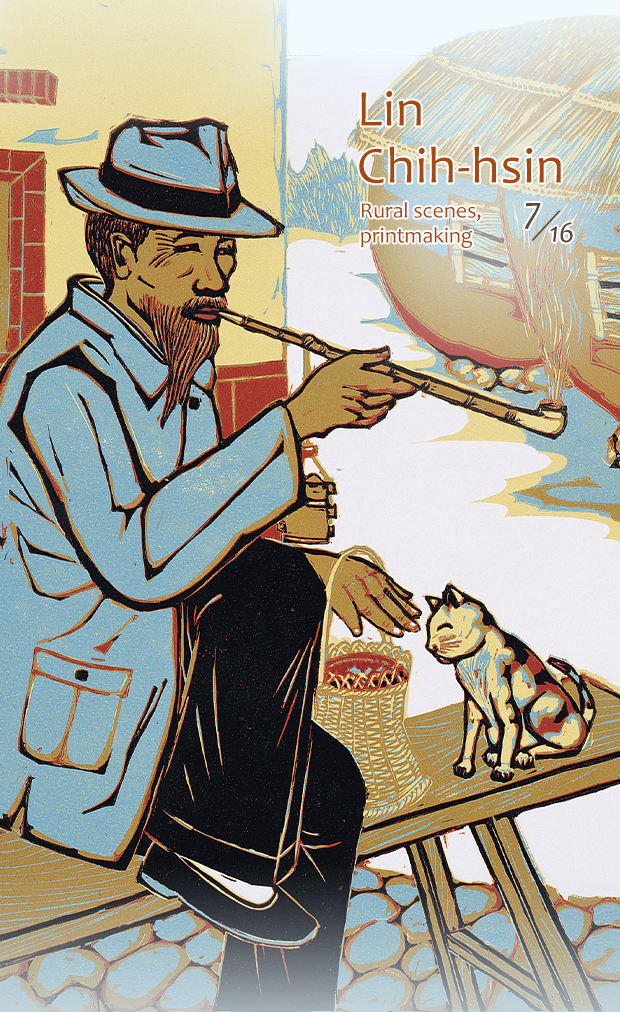

Lin Chih-hsin (1936-) was born in Tainan's Kuijen Township on July 16, 1936, and graduated from the Art Teacher Training Department of the Taiwan Provincial Tainan Normal School, present day National Tainan University. His interest in fine art began when he was culturally baptized into traditional artistry as a child through pressing ang ku kueh (red tortoise cake) molds and Matsu pilgrimage celebrations. In 1952, he gave up his guaranteed admission and enrolled to train as an art teacher at the Tainan Normal School. During his time at the school, he became inspired by the woodcut technique of Chang Lin-hsu. The support of Yang Yuyu, then-editor of Fengnian (Harvest) magazine who published several of Lin's works, cemented his decision to concentrate on woodcut printing as his preferred medium.
In 1955, Lin accepted a teaching position at Kuanmiao Elementary School in Tainan, teaching art to young children. While there he helped students enter international children's competitions, winning them numerous awards. In 1965, he himself received first prize in a national competition for outstanding teachers.
Visiting Japanese art museums in 1973 imbued in Lin a deeper sense of the value of creative expression, inspiring him to pursue Picasso's approach to well-rounded artistry typified by comfort with various techniques. While for Picasso this meant perfecting engraving, painting, sculpting and modeling, Lin incorporated into his repertoire Chinese ink painting, printing, koji pottery, sculpting, oil painting and glasswork.
At first, Lin's printwork continued the legacy of Chang Lin-shu's Chinese New Printing style defined by finely incised monochrome woodblocks. Later he incorporated the bold techniques of Japanese printmaker Shikō Munakata, in which each clear, distinct and powerful incision works to construct a simple and lively aesthetic. In 1973 he studied koji pottery in Chiayi with Master Lin Tien-mu, who himself had studied with koji master Yeh Wang.
Lin through his work seeks to “grasp his home soil and encapsulate the feeling of home.” By creating art inspired by the “Taiwanese homeland,” Lin records the aesthetic essence of life buffeted by social change, fulfilling his commitment to preserving Taiwanese culture and artistic innovation. With his boundless creativity, he wishes to give something back to the land he so cherishes.
From 1975 to 1995, Lin completed the “Celebrating Matsu” series of water-based woodcut prints to a combined length of 124 meters, and between 1989 and 2014 created a series of oil paintings called Formosa the Beautiful measuring 248 meters end-to-end, forming what were at the time the longest continuous works of their kind in the world. In 2014 he began work on the Beautiful East Taiwan series of oil paintings, which he intends to combine with the previous two series to form the Love Taiwan Trilogy.
Unique in its depiction of Taiwan and folk customs, Lin's work has succeeded in drawing international attention. Many touring exhibitions and printmaking biennials have shown his work, both within Taiwan and overseas. Even the post office has commissioned him to produce a series of postage stamp designs. He is also the first Taiwanese artist to be invited to tour a solo exhibition around China.
Lin has served on the jury of several art and printmaking exhibitions in Taiwan, and has received numerous awards since 1980. In 2002, he was included in the Cambridge International Biographical Centre's Who's Who in the 21st Century for his artistic achievements, and in 2019 he published The Memoir of Lin Chih-hsin, bringing together his many achievements throughout his illustrious career.
After developing interest in one of his early monochrome prints, the National Museum of History between 1973 and 1983 invited Lin to participate in a range of exhibitions around the world, including in France, the Netherlands, South Korea, Japan, the US, Uruguay, West Germany and Australia. His vigor and unique style have earned Lin international acclaim, contributing significantly to Taiwan's international profile and cultural exchanges.
In 1982, Lin held an exhibition of his woodblock prints in the museum's National Gallery and was awarded its Honorary Gold Medal. Between 2000 and 2016, the museum organized overseas exhibitions of Celebrating Matsu at the M.K. Ciurlionis State Museum of Art in Lithuania, the Latvian Museum of National History, the Bavarian National Museum in Germany and the Ningbo Museum in China. In 2000 it organized a solo show “Carvings of Home — An Exhibition of Lin Chih-hsin's Printmaking” and published an exhibition catalog. To express his gratitude for more than 30 years of collaboration and give back to the nation that nurtured his creative life, Lin donated the works to the museum after the exhibition concluded. The museum now boasts 163 of Lin's printworks, which are regularly put on display.










